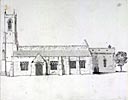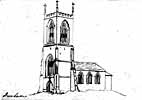 Dunham on Trent Dunham on Trent
St Oswald
History
The village, although not the church, is mentioned in Domesday Book and at this time is shown as belonging to the King. The entry reads ‘In Dunham on Trent, with its 4 Berewicks, Ragnall, Whimpton, Darlton and ‘Swanston’ [in Dunham]. King Edward had 5.5 carucates of land to the geld. There is land for 12 ploughs. Now the King has 2 ploughs in demesne; and 50 villeins and 3 bordars having 10 ploughs, and 1 mill rendering 3 shillings and 1 fishery rendering 10 shillings 8d, and 120 acres of meadow. There is woodland pasture 6 furlongs long and 4 broad. TRE it rendered £30 and 6 sesters of honey; now £20 with everything that belongs to it.’ Although a church or priest is not mentioned it is likely that in a holding this substantial that there would have been a church or chapel.
The present building is Grade I listed, with the west entrance gate, the north entrance gate and some of the headstones being listed separately, as Grade II.
One of the earliest references to the church is during the reign of King Henry I when it was noted that ‘King Henry the first, gave to Thurstan, archbishop of Yorke, the church of Dunham, that he might make it a prebend in the church of Southwell, as in that place is already said.’ This prebend was founded between 1119 and 1135.
In the 1291 taxation of Pope Nicholas IV the prebend of Dunham was valued annually at £36 13 s 4d, and the vicarage at £4 13 s 4d. Fifty years later, at the 1341 Nonarum Inquisitiones, there is no mention of the church or vicarage. At the 1428 subsidy of Henry VI, Dunham appears under the heading of a prebend of Southwell, and was taxed at 73s 4d, which is 10% of £36 13s 4d showing that nothing had changed in the annual value since 1291.
On 10 October 1309 after the churchyard had been desecrated (no details are given) it was ‘reconciled’ by Archbishop Greenfield. However it probably related to an incident two years earlier where the archbishop issued a mandate to the dean of Retford to enquire about an assault in Dunham churchyard on the vicar by certain of the inhabitants. Two days after this mandate was issued, archbishop Greenfield instituted an ordination between the parishioners and the vicar of Dunham stating that Mass was be celebrated on certain days, and on these days and Sundays, matins, high Mass, and vespers were to be sung. The archbishop also instructed ministers not to frequent taverns but to look after the sick, and they were instructed not to strike parishioners, perhaps hinting at the cause of the trouble. No animals, except for tithe lambs, were to pasture in the churchyard. Finally, the order was given that this ordination was to be read four times a year in Dunham church.
In 1315, the parishioners of Dunham were singled out for a reprimand by the archbishop who demanded the excommunication of the persons who had taken the archbishop's swans in the Trent at Laneham, unless restitution was made.
In 1414 a chaplain was appointed to Dunham to help sort out disputes arising amongst the villagers. On 31 October 1458 the Chaplain of Dunham, one Thomas Goldying was pardoned of his outlawry for not appearing before the justices to answer for a debt of £40 claimed against him by John Bate, prebendary of Dunham.
When Southwell Minister was surrendered to Henry VIII’s reforms in August 1540 the prebendary of Dunham was disposed. Although it is probable that the vicar continued his duties this suspension lasted for 3 years. After this by special act of Parliament the Minster was reconstituted exactly as before.
In the Tanner MSS it is recorded that 1676 there were 146 inhabitants of an age to receive communion, there were no Roman Catholics and no Dissenters.
In Archbishop Herring’s returns of 1743 it was noted that there were 62 families in the village with no dissenters. There was no meeting house in the parish. There was, however, a public school which was not endowed, which between 40 and 50 children attended. Part of their time was spent learning the Catechism and for such they were brought to church.
There was no alms house and the lands which were let to help maintain the church brought in an income of about £3. The origins of the lands were unknown to the incumbent.
The incumbent resided in the vicarage and managed the parish on his own as he did not have a curate. All those under his care at this time were baptised, but 10 people were not confirmed.
He read the public service on Wednesdays and Fridays and twice every other Sunday. He also had a chapel in which he also spent time.
He carried out the catechism at Lent, after Easter and at Harvest Festival. He did note that it was very hard to get those who were not educated to be instructed. He also administered the sacrament 4 times a year, and of the 145 communicants about 36 or 37 received this office, despite the fact that he refused none.
By 1764 during Archbishop Drummond’s visitation the number of families had increased to 70. Of these, two were Roman Catholics, but there were still no meeting houses, alms houses, hospital nor a charity school. Despite this there was a legacy of £100 which was distributed to the poor.
The church was maintained by the parish as there were no lands set aside for this purpose. There had been no increase in the living under Queen Anne’s Bounty, but there was a yearly payment of £10 left by a prebendary of Southwell.
The vicar lived in the vicarage at Kneesall and the curate, the Rev Thomas Newbound, lived in Dunham, but not at the vicarage, as the late vicar’s widow lived there.
Services were performed in the mother church one Sunday and then in the chapels of Ragnall and Darlton the succeeding Sunday. There were no attendees who were not baptised or who were not confirmed if of a suitable age. The children are taught the catechism. The Sacrament was administered 5 times a year at twice at Easter, then once at Whitsunday, Michaelmas, and Christmas. It had not been refused to anyone.
The chapels were served by the curate every other Sunday. The chapels paid a very small tithe, and had no endowments.
During the 5 years 1788-92 there were 54 births and 22 burials in the village. In 1793 there were 260 inhabitants.
 The church from the The church from the
south in 1773 |
 The church in the early The church in the early
19th century |
By the late 18th century the church was 'greatly decayed in the foundation, walls and roof'. In 1795 the parishioners certified at the Retford Quarter Sessions that although they had spent large sums of money on repairs from time to time 'yet by the very frequent inundations of the river Trent, and a large mass of ice which drove upon it during the late extraordinary floods of last winter the same has become so ruinous that it cannot any longer be supported, but the Body must be taken down and rebuilt.' An estimate of £1478 10s had been received for rebuilding the church and as this sum was beyond the means of the villagers they sought a Church Brief to raise the funds through collections in churches and elsewhere throughout England and Wales. The Brief was authorised on 28 June 1796.
Despite the fact that the vicar was given 92 acres of land in the 1803 enclosures it was noted in 1805 that the church was still in a disgraceful state. Bailey (1855) recorded that in 1805 the church 'with the exception of the tower, rebuilt this year. Previous to this reparation the chancel had long been in a disgracefully ruinous state.' The church reopened on the 27th of April, 1806.
When the Reverend H. Jubb arrived in 1856 he was shocked at the state of the church: 'an ugly little nave with a still uglier apse for a chancel, a mean table for an altar, and two miserable pews blocking up the space.' He caused the nave to be rebuilt and a north aisle to be added, while at the same time the Ecclesiastical Commissioners (the rectors) added a chancel. The architects were Hine & Evans of Nottingham. The church was reopened on 1 October 1862 by the Bishop of Lincoln.
In 1903 the church was renovated. The Lincolnshire Chronicle provides a summary of the work:
'The actual work has been in progress about a month, during which time the services have been held in Ragnall Church. The work has been confined mainly to the chancel—towards the cost of which the Ecclesiastical Commissioners have largely contributed,—placing a new window in the south aisle, relaying the floor with Minton tiles, and replacing the old deal stalls with oak ones. The nave and aisle have been redecorated, while a short time ago a new organ was placed in the edifice. The whole cost he been about £300.'
Despite the flood defences there were further serious floods in 1910.
On 1 February 1914 Edwyn Hoskyns, the Bishop of Southwell, visited the parish. At this time the living was vacant and the parishioners were served by a curate, the Rev T.E.S. Ferris M.A. The net annual value of the benefice was £190, the church could accommodate 230 people, and there had been eight baptisms and 1 confirmation in the year ending 30 September 1912.
In 1930 it was reported that Dunham required a large sum of money for repairs. The tower was restored this year but apparently work was still required on the roof.
In 1952 Taylors of Loughborough recast the treble bell and rehung the bells in a new cast iron frame; this was the first time they had been rung for 50 years. In 2006 a sixth bell was added to the ring.
By 2016 the church had closed and was awaiting a new use.
| 


 The church from the
The church from the The church in the early
The church in the early





